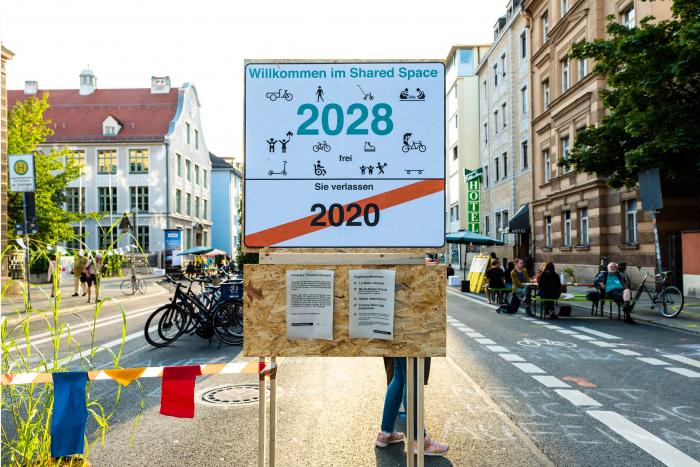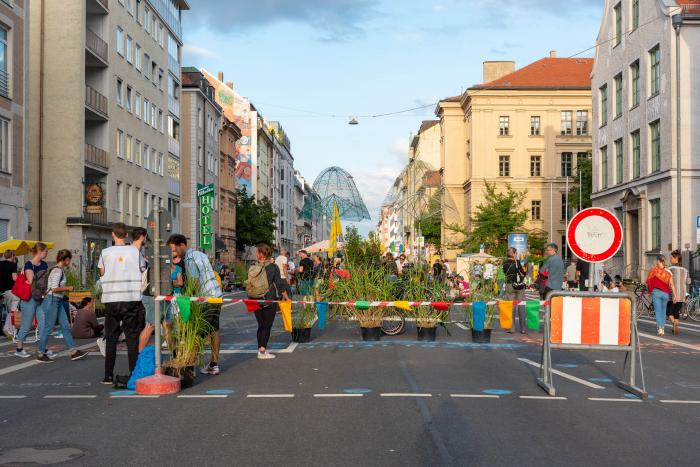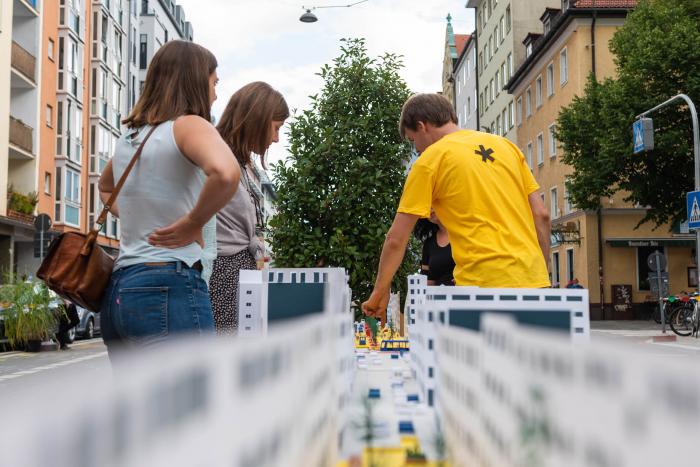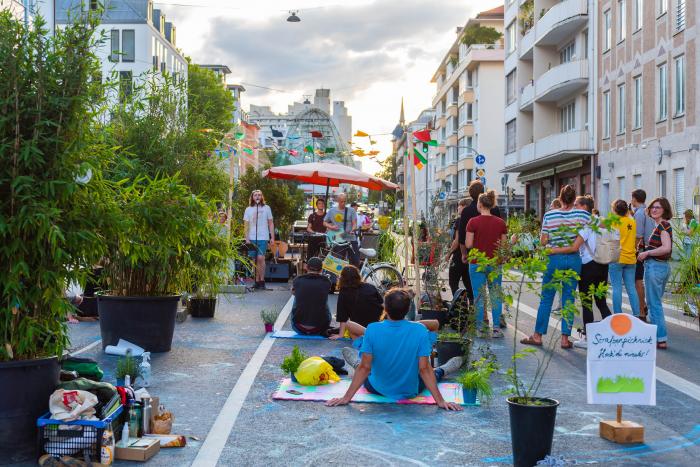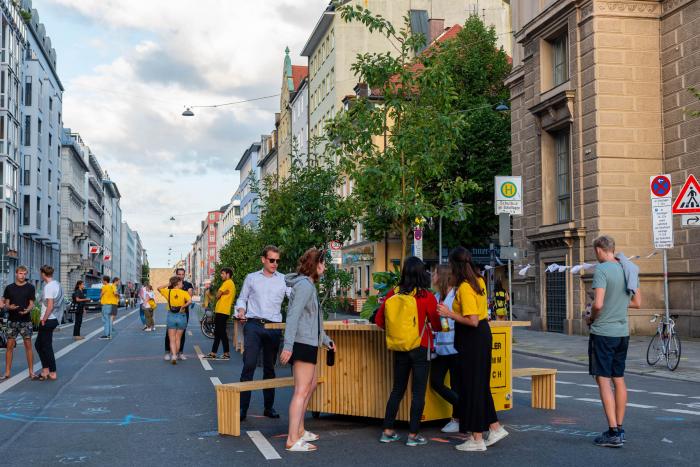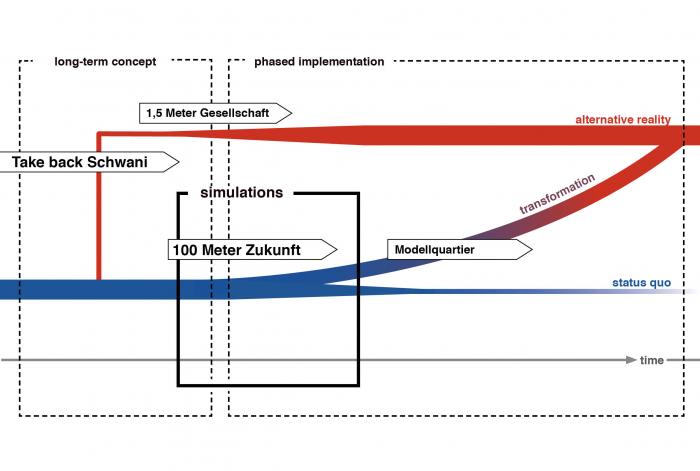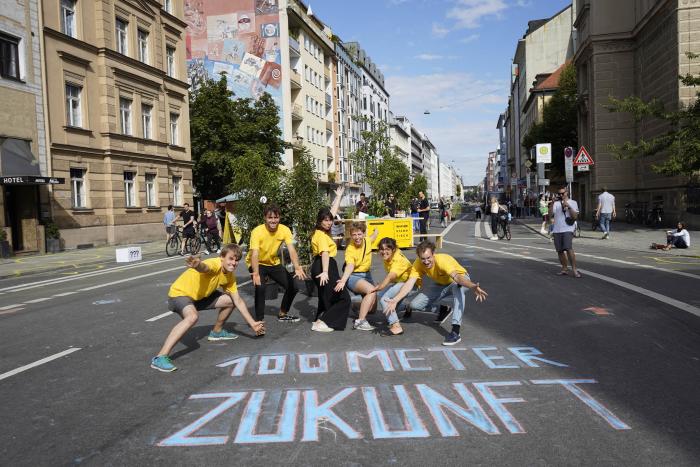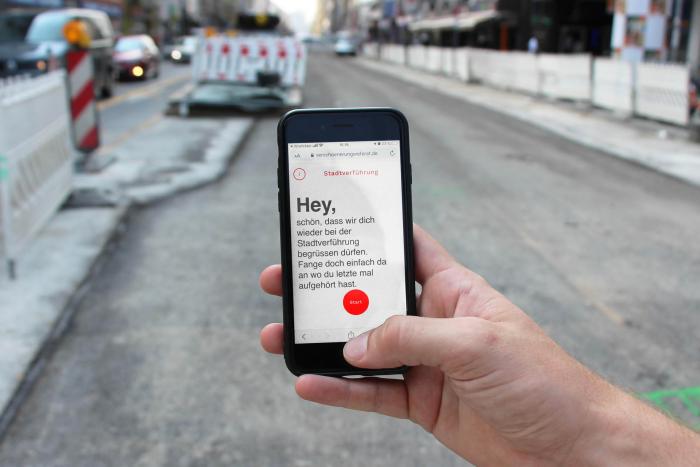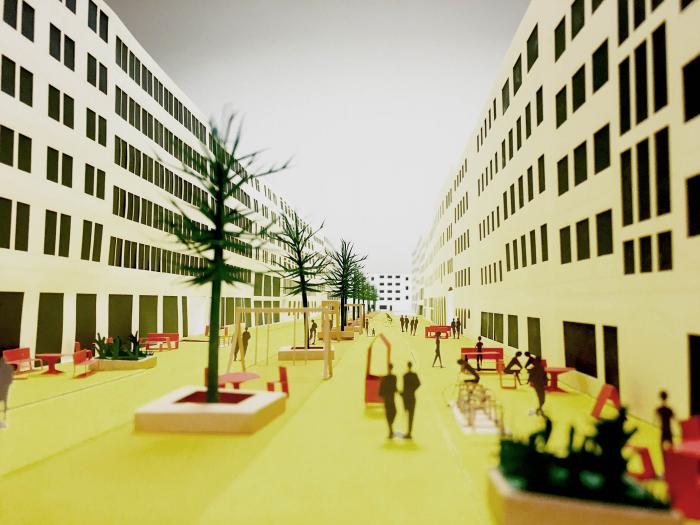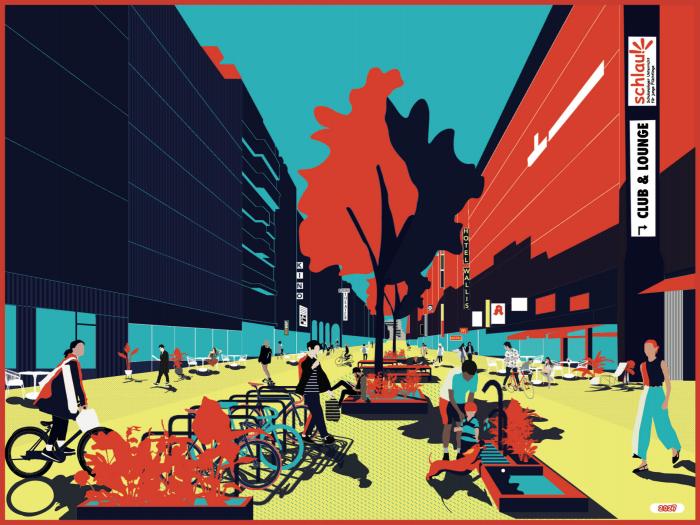I. SUMMARY INFORMATION
Project
269538
Status
Submitted
Award category
Mobilisation of culture, arts and communities
You want to submit
NEW EUROPEAN BAUHAUS RISING STARS : concepts or ideas submitted by young talents (aged 30 or less)
Project title
Referat für Stadtverbesserung*
Full concept/idea title
Referat für Stadtverbesserung* - any resemblance to a existing institutions is purely coincidental
Description
“What is achievable to improve Munich’s public space?” - with this idea we started the “Referat für Stadtverbesserung*” (Department for urban enhancement). We are oriented to municipal works, turning already existing concepts and decisions into reality. Architectural interventions and simulations are aimed at creating disruptive moments, which question the dominance of traffic and introduce other uses to create democratic spaces, making the city socially and ecologically resilient.
Where is your concept/idea being developed or intended to be implemented in the EU?
Germany
Bavaria
Johann-Clanze-Straße 32
Munich
81369
II. DESCRIPTION OF THE PROJECT
Please provide a summary of your concept/ idea
One and a half years ago, students of architecture, urbanism and landscape architecture founded the Referat für Stadtverbesserung* (City-Departement for urban enhancement) without a municipal mandate but with the urgency, that such a department is needed when city-planning has to cope with both climate change and rising social inequality. It is both a conceptual project on lobbying for a socio-ecological city and a mode for us to not only phantasies but actually practically changing the city for the better. Bridging the gap between virtuality and reality we concretize and implement concepts and political decisions. Our actions are layered and oscillate between activism, social-entrepreneurship as well as political involvements on different levels to lobby for a more just city. We are addressing the monofunctionality of public space, being mostly used for traffic. These spaces could be valuable uncoded spaces, serving multiple uses for environmental and social sustainability. Nevertheless, these potentials are unnoticeable in the everyday. Therefore we developed the urban simulation, to use experiences as a communication tool with a lowthreshold. Disrupting the status quo, they stimulate the imagination of the citizens. Through temporary simulations, problems can be evaluated on demand and long-term concepts can be improved. For this reason, simulations are the first and an important step on the way to a sustainable and social future. An example-project is our work for the communities in Schwanthalerstraße, Munich. The street is a major traffic axis into the inner city, connecting diverse neighborhoods with flourishing culture, while not serving the communities with valuable public space. Following the motto »if we can make it there, we can make it anywhere«, we developed a long term concept and made it tangible with our life-size simulation »100 Meter Zukunft« (100 meters of future).One day the street was not dominated by traffic but by the life of the people.
Please give information about the key objectives of your concept/idea in terms of sustainability and how these would be met
We understand sustainability as measures to examine whether our work contributes to both a socially inclusive and ecologically resilient city. The biggest problems cities are facing today are stemming from climate change and social injustice, therefore city-planning needs to address these topics in a sustainable way to ensure that cities are not only places people need to but people want to live. In the end adjustments need to be made to the surroundings of our everyday, which is in most cases the city. To make Europeans favorite place to live, the city, more biodiverse and climate-neutral, we are engaging in public space and in particular street spaces, because these are still optimized for combusting rather than compensating the pressing problems of cities. Today, street spaces are dominated by motorized individual traffic and sealed surfaces. There is still untapped potential in terms of both climate protection and adaptation. We are thus mainly led by the following questions: How must the space be designed to provide space for future-proof forms of mobility but also reduce traffic in favor of other uses of public space? How do we accelerate the necessary adaptation of our cities to climate change by improved green and blue infrastructure? And how can these questions be answered without consuming large amounts of resources for large scale urban redevelopment? We are convinced that thoughtful and sensitive interventions are necessary in the intermediate between testing and permanence. Therefore our simulations come in place. By intuitively grasping and feeling the interventions, they can be evaluated just-in-time, improved for structural permanence and achieving thus the goal of creating a large effect with fewer resources. This way of working corresponds to our understanding of the city, which we see as constantly inconstant and unfinished.
Please give information about the key objectives of your concept/idea in terms of aesthetics and quality of experience beyond functionality and how these would be met
The quality and functionality of the street space lies in a generic use of it. This requires that the design allows a certain flexibility and the multicoding of areas. Other than in architectural projects, where laws and regulations are still offering a certain playing field for creativity, sticking to the rules in urban and street spaces often leads to overregulated and clean aesthetics that are obviously designed by regulations rather than creativity. To be able to quickly innovate within public space we have to explore and bend legal boundaries, playing with stolid administration, making the seemingly impossible possible. The "mobiler Stammtisch" (mobile regulars), a moving tree with a table and removable benches is a great example of this approach. In no time it transforms a parking lot into a green place for people to rest, without needing permission of local authorities or being controlled by them. Architectural elements, such as this one, visualize alternative realities with only a few resources and embrace the multicoded streetscape. However, coming from planning and design studies, it is our concern to not make it look improvised but create a professional appeal to such elements, in order to camouflag the interventions making them already part of future street-infrastructure. We want to raise the aesthetic bar of public interventions so they are taken seriously – and so the concepts behind them. Therefore we support civil society actors who are committed to improving public space. By supporting them with a professional design perspective, contributing through co-creation processes, we want to maintain aesthetic qualities, enhancing the everyday making change not a matter of discussion but of experience. Doing so, we are working not only with build but also grown matter. In order to show the spatial effect of greenery, we are greening the city both artistically and temporary making people aware of the temporality of space but also of the permanence of trees.
Please give information about the key objectives of your concept/idea in terms of inclusion and how these would be been met
As we are acting on municipal level, inclusion and improvement of disadvantaged groups in society is of great importance, as we are working close to the everyday realities of the people. This is one reason for our engagement at the city level and our naming of the initiative “Referat für Stadtverbesserung*” in reference to a municipal administration. Many codesign and participatory formats fail to include the most vulnerable because they are not sufficiently addressed. Often various barriers, such as language or time, hinder these groups in stating their voice. Therefore, in our socalled simulations, such as “100 Meter Zukunft”, we focus on the experience and direct engagement through the temporary presentation. This enables accessibility and open discussions that overcomes barriers and provides insights into the needs of different people. Being aware of the different groups and taking into account their needs is the first step in creating a socio-ecological city. In our view, a plurality of usecases of the public sphere supports a plurality of people too. Children and the people with reduced mobility benefit from more traffic safety. Green spaces offer recreation close to home for the financially weak and extend their otherwise rather small living spaces in cities that are getting more and more expensive. However, these groups only profit if the interventions do not promote gentrification and commercialization. We are therefore paying close attention to creating a place free of consumption. After all, public space is a democratic space that should promote exchange across social and cultural strata. To foster exchange, we act especially in places that are not in the center of public consciousness or are negatively afflicted. Bad reputation fails to recognize the diversity that exists and the important characteristics of these inclusive places. We see it as our obligation to raise awareness for these characteristics and groups.
Please explain the innovative character of your concept/ idea
We separate ourselves from many other initiatives through the act of doing. Through different modes of financing we exceed the default idea of the planner as a service provider but understand planning as a political act. Concepts need to be executed to be viable. Compared to established actors in urban planning our mode of work allows us to quickly implement new solutions. We understand innovation as the creation of real and contextual changes that disrupt the status quo located between vision and reality. For this reason, city should be designed on the streets and not only in offices of administrations or investors. In our opinion, the city can be shaped and is subject to constant transformation. Plans and pictures are not enough to actively change the city in a positive way. That is why we also think in terms of the social and economic structures that lie behind the projects promoting change, making us both an initiative and project in itself – giving potential changemakers access to our knowledge through talks and further publications. Our approach to urban design understands planning not as the production of a finite state but as a continuous process, which is why every intervention in the urban space should achieve as much output as possible with as little input as necessary. We understand space as a multi-layered stack of analog and digital spaces, merging together. An example of this is the so-called "Stadtverführung", a digital asynchronous soundwalk that leads through Schwanthalerstraße and adjacent neighbourhoods opening up possible future scenarios to the listeners. This somewhat different city tour promotes innovative thinking through the claim, that change has already happened, making it a self-fulfilling prophecy.
Please detail the plans you have for the further development, promotion and/or implementation of your concept/idea, with a particular attention to the initiatives to be taken before May 2022
As we are still in the transition phase coming from university going into the working world, finding feasible modes of organizing and funding is always an issue. To engage ourselves in a context beyond the university, we are currently acquiring resources and transferring the initiative into an NGO. This will enable us to develop further solutions and tools for cities all over Europe. Nevertheless we are already working on projects, talks, workshops and publications both in Munich and extending. We will be simulating a different approach in organizing residential streets in the heart of Munich, hopefully creating a concept that could be implement in many street within only a few years. Our simulation will be held over several weeks, making it possible to evaluate and discuss the local impact and future-proofing it with authorities so local administration can work as a multiplier of this idea. This will allow us to evaluate the interventions more precisely through quantitative and qualitative methods. In addition to temporary actions, we are constantly trying to make individual elements of our simulations permanent. Thus, the tree in the middle of our “mobiler Stammtisch” will find a permanent place in the street and symbolically stand for the greening of the street space. We have also succeeded in winning over further initiatives and donors for Schwanthalerstraße. Moreover we are looking at different other sectors that we could be intervening such as vacant buildings – a project that we are working on together with students from school within Munich – as well as digital tools to extend our knowledge of the citiy. Furthermore we will be rolling out a project in September concerning the footprint of the parked car within the city, taking advantage of the IAA (international motor-show) as an accelerator but also criticizing the dominance with which it will be prominently parked within the city center. Together, we will gradually implement visions and improve the city.
III. UPLOAD PICTURES
IV. VALIDATION
By ticking this box, you declare that all the information provided in this form is factually correct, that the proposed concept/idea has not been proposed for the New European Bauhaus Rising Stars Awards more than once in the same category.
Yes
